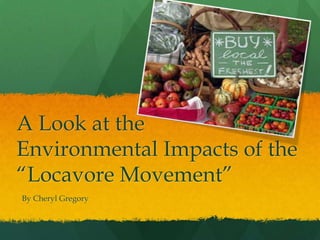
Environmental Impacts of the Locavore Movement
- 1. A Look at the Environmental Impacts of the “Locavore Movement” By Cheryl Gregory
- 2. 1. What is the Locavore Movement? Outline: 2. Some of the Misconceptions A. Transportation B. Food Distribution Organization C. Growth / Production Methods D. Food Types E. Globalization of Food Systems F. Proposed Local Benefits 3. Conclusion
- 3. What is a “Locavore”? Term first coined by Jessica Prentice of San Francisco on the World Environmental Day in 2005 Describes a person who consumes only food grown or produced locally Usually food is produced less than 100 miles away Locavore Movement: “A collaborative effort to build more locally based, self- reliant food economies-one in which sustainable food production, processing, distribution, and consumption is integrated to enhance the economic, environmental and social health of a particular place” Gail Feenstra UC Davis http://www.youtube.com/watch?v=Q W-pBX-yw&feature=related
- 4. “Food Miles” “Food Miles” is the distance a food product travels from the source of production to the plate of the consumer Originally the local food movement used the concept of food miles to determine the sustainability of food Food Miles oversimplify the complex environmental impacts of a food system
- 5. Distribution What is a Food System? Production Processing Distribution Storage Use Waste
- 6. Transportation Variables Coordination of Transport Overall reduction of greenhouse gas emissions Reduces Gridlock Mode of Transport Airplane vs. Cargo-ship vs. Truck vs. Train “Just over a ton of goods moved six miles as Technology Advances part of a 22 ton lorry load generates about Diesel-Hybrid Engine 14 oz of CO2; moved in 50 cars, each Fuel Types carrying 40 lbs, it generates about 22 oz of CO2” (Woods et al)
- 7. Distribution Theoretical Local Current Distribution System Systems More Direct Collaborative Distribution Smaller Warehouses System Coordination/Sharing of Less Storage Time warehouse and Less Refrigeration transportation systems Reduces gridlock However, decreasing the Ability to maximize size of the operation but efficiency increasing the number of operations may not Competitive Distribution actually decrease System environmental impact. Companies act competitively which may not be in the best interest of the environment
- 9. Growth/Production Theoretical Local Reality of Buying System Local Promote Sustainable Care Organic vs Inorganic of the Land Overlooks Climate Differences Decrease Mono-cropping New Zealand vs United No Barren Fields during Kingdom Winter Months Does not Consider Fertilizer, Pesticide or Herbicide Use
- 10. Food Type Key Flaw of the Locavore Movement The Environmental Impact varies drastically from food type to food type. Example: Beef has a much higher negative impact than vegetables Locavores Believe that Local Consumption will cause people to naturally decrease their intake of environmentally damaging foods Lacks support from research Haiti is an example of a country which consumed locally produced rice, despite environmental effects, until the land became desert
- 11. Globalization The Locavores View Reality Food Miles have increased significantly but: “Globalization of the food market has only increased greenhouse gas emission by 5%” (Liaw) Regional Specialization Crops grown where produced most efficiently Could Mean Less Pesticide/Herbicide/Fertilizer Use
- 12. Proposed Local Benefits Preservation of Local Food Heritage Preservation of Local Culture Economic Freedom from global market fluctuations “A community which depends upon its human neighbors, neighboring lands, and native species to supply the majority of its needs must ensure that the social and natural resources it utilizes to fulfill those needs remain healthy.” Kloppenburg
- 13. Obstacles in Achieving Proposed Local Benefits 1. Recognition of an Unhealthy Resource 2. Recognition of the Cause of the Unhealthy/Damaged Resource 3. Creating Action or Behavior Change to A. Prevent Further Damage to Resources B. Reverse Current Damage to Resources C. Restore/Improve Resources Essentially, ENVIRONMENTAL EDUCATION & ENVIRONMENTAL PLANNING is also necessary in order to realize the benefits of consuming locally!!!
- 14. 1. Overlooks Differences in Conclusion Transportation The Locavore Movement 2. Distribution is over- overlooks some key factors of simplified the food system with huge environmental impacts. 3. Lack of emphasis on Growth/Production Methods However, with more research 4. Ignores Differences in and some adjustments to the Local Food campaigns, Food Type particularly environmental education, a local food 5. Does not address the economy has the potential to obstacles of achieving the reduce negative environmental proposed local benefits impacts of current food systems.
- 15. Suggestions Suggested Reading: Michael Pollan´s The Omnivores Dilemma Try to cut back on animal products, especially beef Try to buy food that has been produced sustainably, and yes, one of the best ways to be sure is by buying from the person who actually did the producing Buy Food Seasonally MICHAEL POLLAN: http://www.youtube.com/watch?v=oFN zabpQ2X0&feature=related